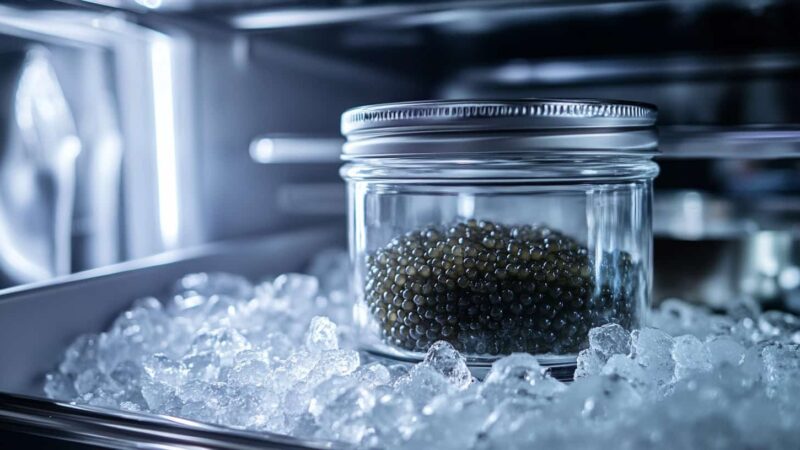In order to know how to store caviar to maintain freshness, we have to follow recommended procedures that ensure that this delicacy is properly stored. Caviar is a very perishable product, and proper caviar storage is essential to preserving its delicate texture and flavour.
Whether you’re dealing with an unopened tin of premium caviar or leftover caviar after serving, understanding how long caviar lasts and the best way to store caviar will help extend its shelf life. It is important to keep your caviar in the coolest area of the refrigerator, ideally in its original caviar container.
By following these caviar storage tips, you can ensure your caviar remains fresh and delicious. Preserving the luxurious experience that comes with every bite.
Ideal Temperature for Storing Caviar
Caviar is best kept at temperatures between -2°C to 0°C (28°F and 32°F), which is just above freezing. This temperature range ensures that the delicacy is fresh without risking freezing the delicate eggs. Keeping your caviar in the coldest part of the refrigerator, typically the back, is recommended to maintain its optimal quality. Temperature changes can affect the texture and flavour, so it’s important to keep the container tightly sealed and avoid any fluctuations.
If you have an unopened tin of caviar, make sure it remains refrigerated until you’re ready to serve it. Once opened, it’s crucial to consume the caviar within a few days to preserve its premium taste and texture. For those looking to extend the shelf life of their caviar, freezing is an option, but only for certain types like pasteurized caviar. Be cautious, however, as freezing may impact the delicate texture of fine caviar.
Easy Tips for Caviar preservation
- Consume within 2-3 days.
- Keep tightly sealed to reduce air exposure.
- Store in the coldest part of the fridge.
- Avoid room temperature exposure.
- Check for changes in smell or texture before serving.
How Long Can Caviar Last After Opening?
Once caviar is opened, its consumable life significantly decreases. Generally, caviar should be consumed within 2-3 days after opening to ensure maximum freshness and flavour. However, how to store caviar depends on the specific type. Keep in mind that the freshness of this highly perishable product is essential to maintain its high quality and flavour.
On our products, you will find expiry dates clearly printed on the back of the tin. Indicating how long the caviar will last when unopened. These dates reflect the storage life of the caviar while it remains sealed and refrigerated. Once the tin is opened, it’s important to refrigerate it immediately and consume it quickly to enjoy the best caviar experience.
For the best results, always ensure that opened caviar is stored properly in the coldest part of your fridge. Tightly sealed to prevent air exposure, which can degrade its quality.
What you need to know about freezing Caviar
Freezing caviar can help prolong its usability, but it’s essential to know that freezing may impact the texture and overall quality of the delicate roe. Certain types of sturgeon caviar, like pasteurized options, are more suited to freezing, premium caviar is typically best enjoyed unfrozen to retain its natural tastes.
If you choose to freeze caviar, place it in an airtight container and ensure it is properly sealed to avoid freezer burn. It is best to leave it in its original tin with plastic wrap to ensure protection, before storing it in the freezer. Once defrosted, caviar should be eaten within a few hours to ensure the best taste and texture. Be sure to defrost it slowly in the refrigerator rather than leaving it out at room temperature to maintain its pureness.
While freezing may help preserve your caviar for a longer period, savour it fresh whenever possible for the finest experience.
Has it gone Bad?
Identifying spoiled caviar is essential to avoid compromising the luxurious experience of this delicacy. Here are some signs that your caviar may have gone bad:
- Off-putting Smell: Fresh caviar should have a clean, briny aroma, reminiscent of the sea. A strong, sour, or overly fishy smell is a clear sign that it has spoiled.
- Unusual Appearance: Check for any changes in colour. Fresh caviar has a vibrant, consistent hue. Dull, faded eggs or any discoloration indicate that the product may no longer be good.
- Altered Texture: Caviar should feel firm and slightly pop when bitten into. If the eggs are too soft, mushy, or have become sticky, it’s a sign that the texture has degraded.
- Unpleasant Taste: Spoiled caviar often has a bitter, excessively salty, or metallic taste. If the flavour is noticeably different or off-putting, it’s no longer suitable to eat.
- Signs of Mould: Any appearance of mould on the caviar or around the container is a definite indication that it has gone bad and should be discarded immediately.
Always check the smell, colour, and texture before serving caviar, especially if it has been opened and stored for a few days. If in doubt, it’s better to be on the side of caution and avoid consuming potentially spoiled caviar.
Preserving Quality
By following our advice about how to store caviar, you can ensure your caviar stays fresh and retains its delicate texture and flavour. Whether you’re keeping it unopened in the coldest part of your fridge or identifying the signs of spoilage after opening, proper care will help you make the most of this luxurious delicacy.
At Tsarscaviar, we pride ourselves not only on offering the finest caviar but also on providing expert guidance to enhance your experience, as we have been in this industry for over 11 years. Storing your caviar correctly ensures that every bite is as exquisite as it was intended to be.
Ready to indulge in our top-grade products? Explore our curated selection of the finest varieties and elevate your gourmet moments. For more tips on serving or choosing the best caviar, be sure to explore our related blog posts.




